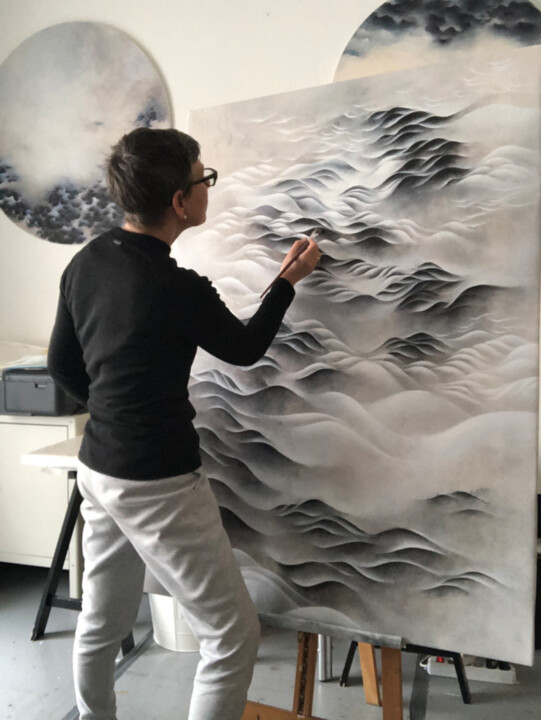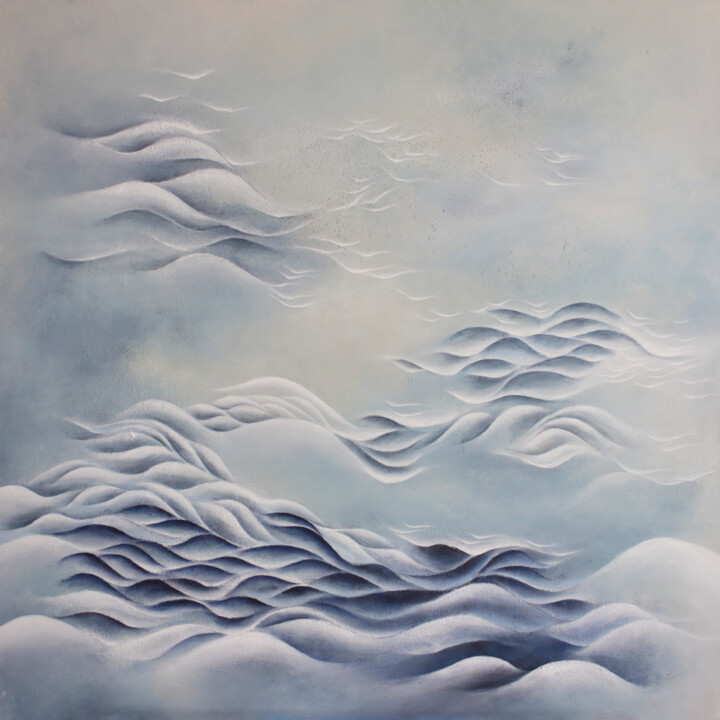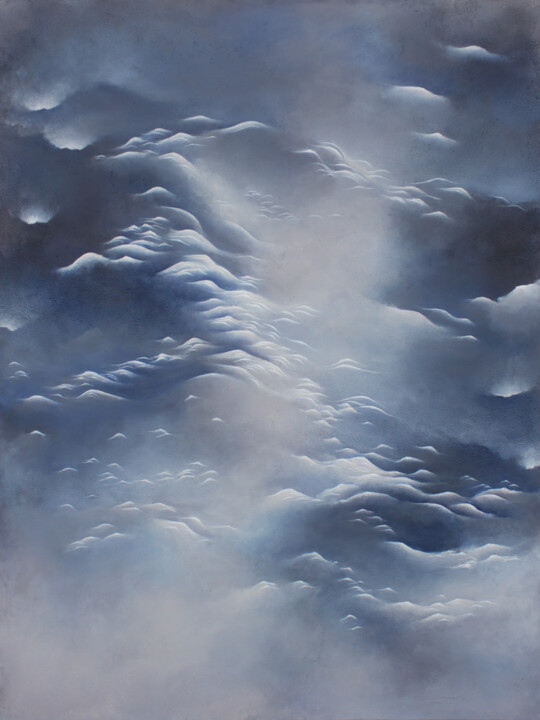
What inspired you to create art and become an artist? (events, feelings, experiences…)
I’ve always enjoyed drawing and painting since I was kid and kept doing it as a hobby until 6-7 years ago. Then I had a medical condition that blocked me at home for weeks. My only way to feel both ‘in synch’ of my emotions and relieved was painting. From that moment onward painting became a daily need, an integral part of my life, not a hobby anymore. It has always been a way to express myself with freedom without any worry or concern. When I paint I’m just me and I feel at ease into my own skin.
What is your artistic background, the techniques and subjects you have experimented with so far?
I’m a self taught artist and used to draw for many years. Since I’ve started to work professionally I mainly used acrylic colours and sand to create dreamy landscapes, cloudscapes and ‘wavescapes’… They allow me to imagine myself in many different forms.
Only very recently I have started again to draw with charcoals. This was triggered by my fear to start an art fair in New York without any of my paintings on canvas - for problems with international shipping. I didn’t want to start the fair with an empty booth, so I went to an art store and bought charcoals and paper. I drew for two days almost non stop - loved it a lot and I also sold many of them during the fair! Btw, my paintings on canvas eventually arrived and, thanks to the help and generosity of many artists and people in New York, I was able to show them from the second day (along with charcoal drawings ever since).
What are the 3 aspects that differentiate you from other artists, making your work unique?
I try to be as much authentic and original as I can, trying to represent the sense of soothing calmness I find when I’m surrounded by winds, grass, water, rocks… I find this way to represent nature quite innovative.
I love to use sand and acrylic colours to get 3D/depth effects that allow the painting to change during the day, depending on the lights in the room. It’s also a way to physically bring earth to the canvas (this is not so original, I’m aware of that :).
I believe my art slowly evolved over time and I love to feel free to keep expressing myself with no fear of change - despite the line of continuity that I think can be found from the first paintings until the most recent ones.
Where does your inspiration come from?
Nature is my main source of inspiration: everything that has a rhythm and gentle movement gives me some kind of calm energy - that’s what I’m trying to capture in my works. It can be anything, also very small and common things such as leaves slightly shaking on a tree branch, the wavy movements of underwater grass in a river, birds flying in the sky… To me, those rhythms are very soothing but also very powerful.
What is your artistic approach? What visions, sensations or feelings do you want to evoke in the viewer?
I try to interest the viewer with whispers and gracefulness, with the idea of being at ease in front of the painting. This often triggers old memories, smiles, the feeling that we all can bring that calmness into our own life. Paintings can be silent reminders of that feeling, despite the intricacies of our daily lives.
What is the process of creating your works? Spontaneous or with a long preparatory process (technical, inspiration from art classics or other)?
I start with a pretty intuitive approach to the canvas, with a lot of action. Then, I completely waive control letting water, color and sand to interact. Then the process becomes progressively more controlled and very slow (not fun to watch - I believe - as nothing seems to happen in a long time :).
Do you use a particular work technique? if so, can you explain it?
I start with a lot of vigorous action when I create the textured ‘sandy’ surface on the canvas. Then, the main configuration comes out from the interaction of sand and very diluted acrylic colour. Then I shape the waves and the chromatic transitions using diluted colour, then thicker layers, veiling and washes, while only the final touches are made of very thick colour up to dry brush.
Are there any innovative aspects in your work? Can you tell us which ones?
More defined and explicit ‘waves’ are typical of my most recent works that I believe are giving more the idea of slow movements. Before I used to create more ‘fuzzy and indefinite’ atmospheres.
Do you have a format or medium that you are most comfortable with? if yes, why ?
I love to mix acrylic and sand because it gives me the the chance to work on an uneven very tactile surface, without being too strong and impactful. Although this also complicates my life as shaping waves on sand is very tricky :)
Where do you produce your works? At home, in a shared workshop or in your own workshop? And in this space, how do you organize your creative work?
I have the studio at home, in a dedicated (very messy) room. I usually work on more than one paintings at a time because this prevents me to become ‘automated’.
Does your work lead you to travel to meet new collectors, for fairs or exhibitions? If so, what does it bring you?
Since 2019 I have had the chance to meet many collectors during direct art fairs (where the artist set up and takes care of his/her own booth): I’ve been several times in London (UK) and recently in New York (USA). The next stop will be Lost Angeles in September.
I love it because of the chance to talk with art lovers, see what they like, dislikes, how the painting gives them certain emotions.
To paint can be very solitary, as I stay hours and hours in the studio just by myself (with music always on). But I believe that creating a painting is like a strange dialogue where I start a conversation that ends only with new eyes watching the painting, getting their own emotions and thoughts out of it. It’s like being part of a communication that has invisible and often unexpected consequences that sometimes become friendships.
And when I get a photo and see where the painting has been hanged, that it is loved… this is such a wonderful feeling of accomplishment.
How do you imagine the evolution of your work and your career as an artist in the future?
I have several ideas about new aesthetic developments.
I also plan to consolidate my presence in the US with some new art fairs in 2024.
On a different ground, I’d love to explore some collaborations with groups that are active in environmental themes.
What is the theme, style or technique of your latest artistic production?
The main theme is creating imaginary places that can be both mountains and waves, water and birds, grass and wind all at the same time. I believe these would be places in which we can feel absorbed, feeling part of nature and hopefully at peace.
Can you tell us about your most important exhibition experience?
Last year I had one of my paintings (Breathe me) selected by the Royal Academy of Arts in London, UK, for the Summer Exhibition 2022. It’s been exhibited for two months in a museum - where Turner (one of my favorite artists ever) had his ‘debate’ with Constable. It’s been amazing to see the painting shown with so many others from both emerging and established artists in a room dedicated to environmental themes and hanged on a wall literally full of clouds.
If you could have created a famous work in the history of art, which one would you choose? And why ?
There’s a painting by Turner (Sunrise, Norham Castle, on view at Tate Britain) where he stretched his technique to an incredible extent. But more than that, it has such a mesmerising light, beauty and intensity. It brings me to an uncanny place of mind that cannot be forgotten.
If you could invite one famous artist (dead or alive) to dinner, who would it be? How would you suggest he spend the evening?
I’d love to invite Rothko, and ask him how he first envisioned his most representative abstract paintings, their sense of indetermination and extension in time. I’d also like to ask him about fear and courage, what his favorite poets were, how he mixed his colours…






 Olimpia Gaia Martinelli
Olimpia Gaia Martinelli




